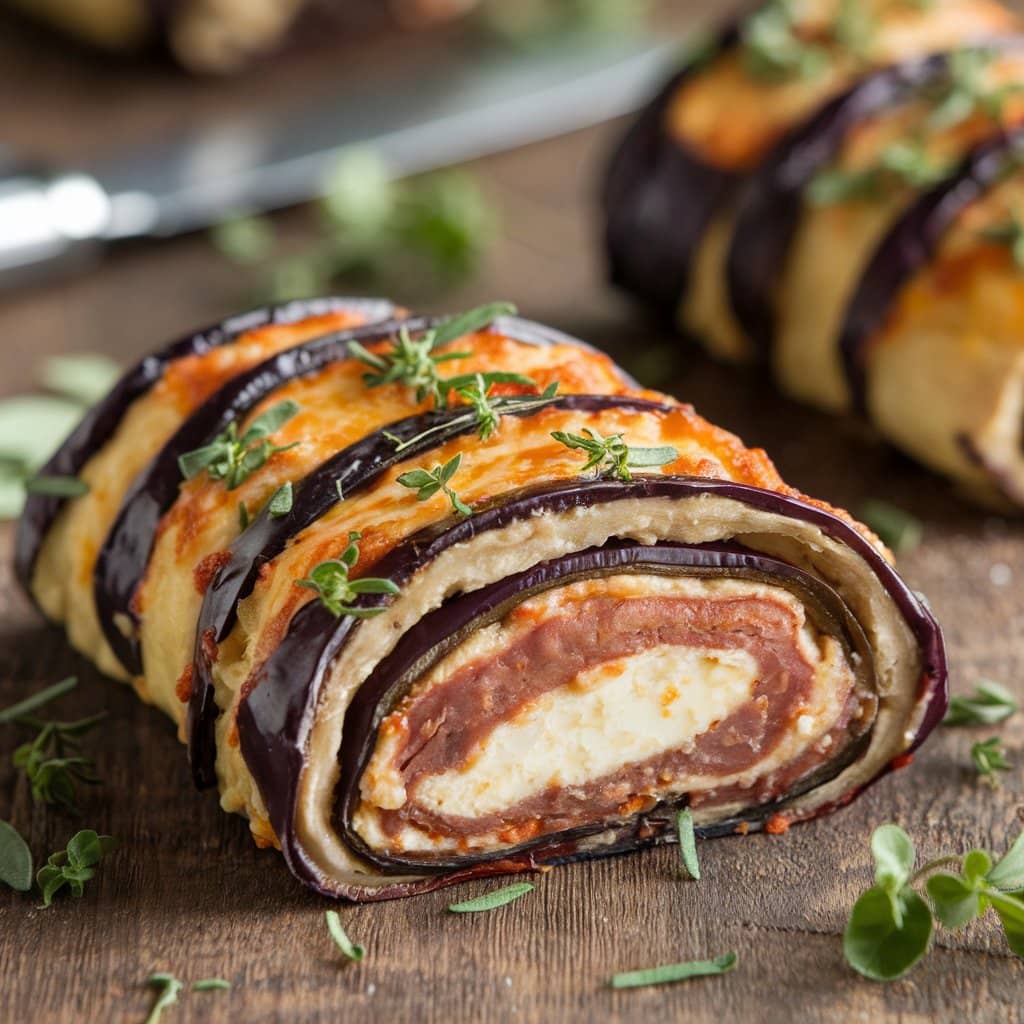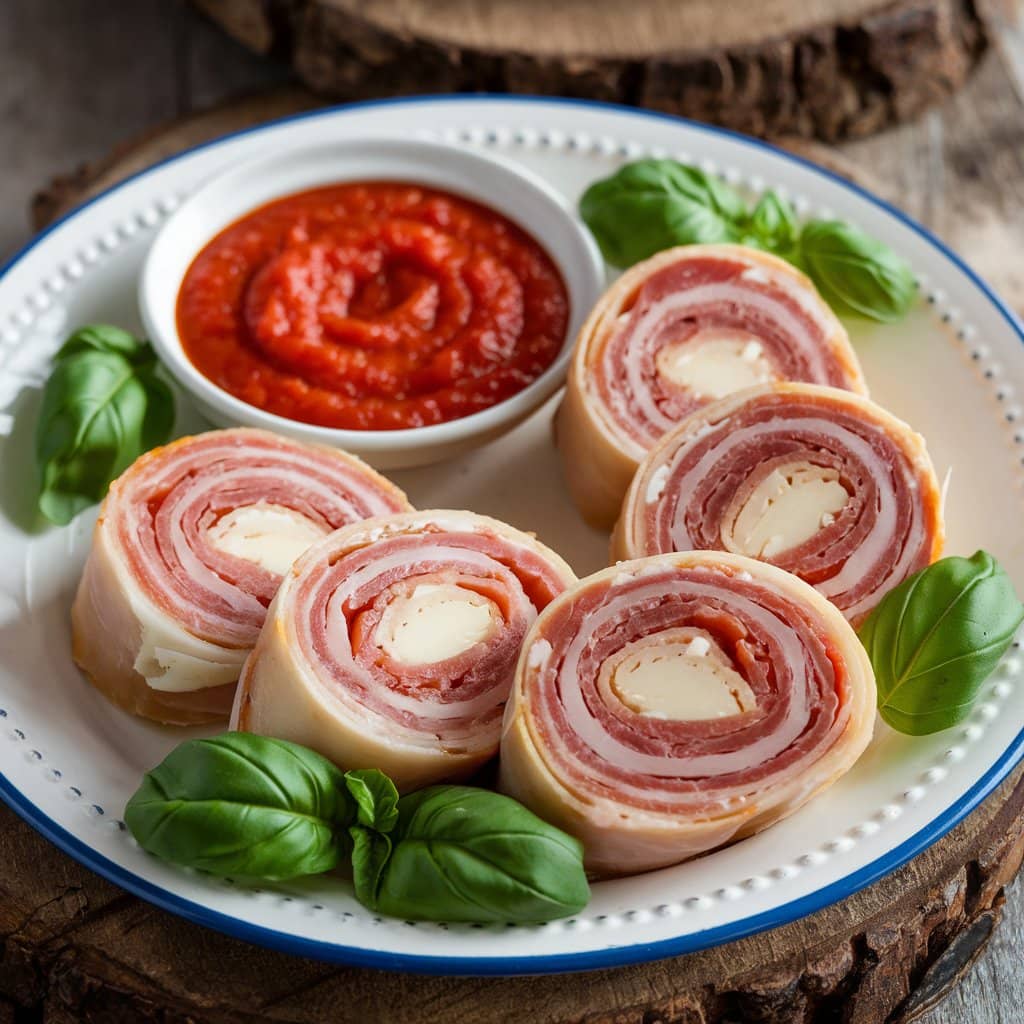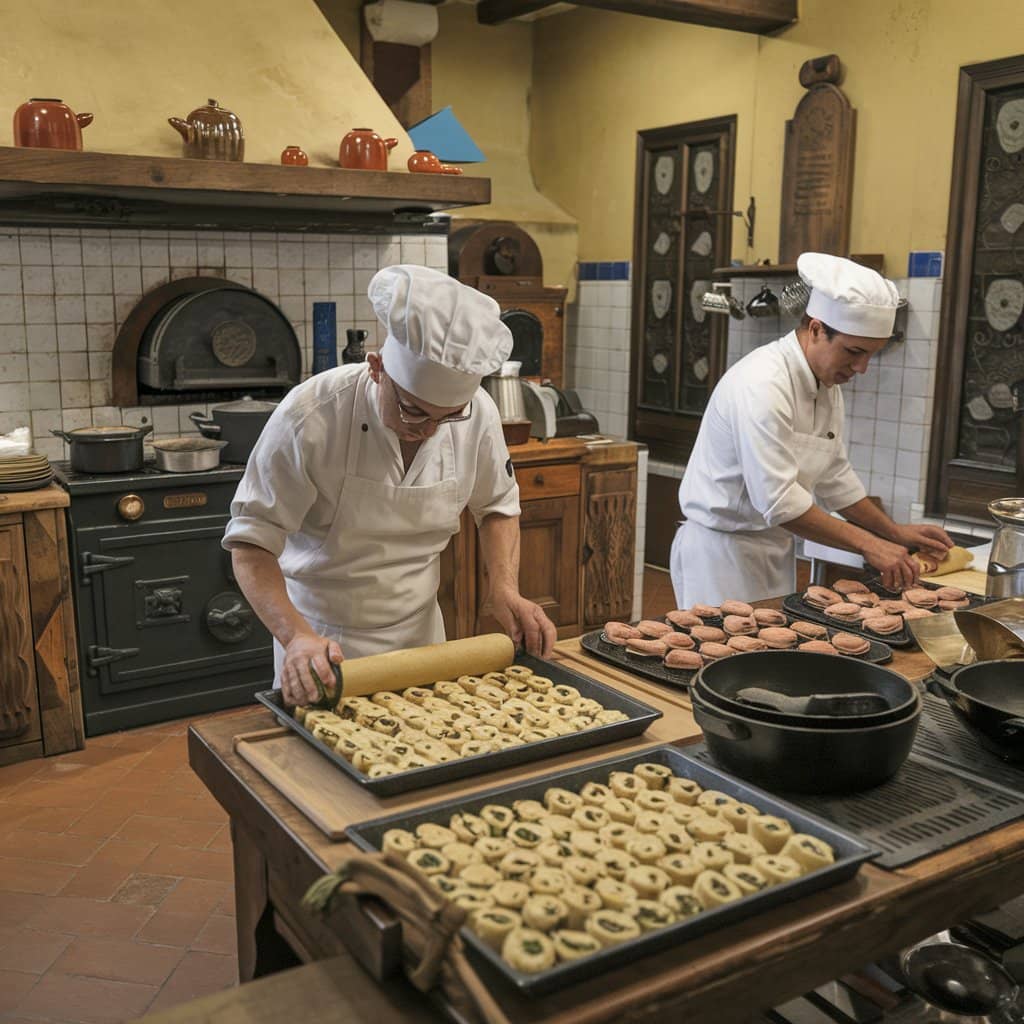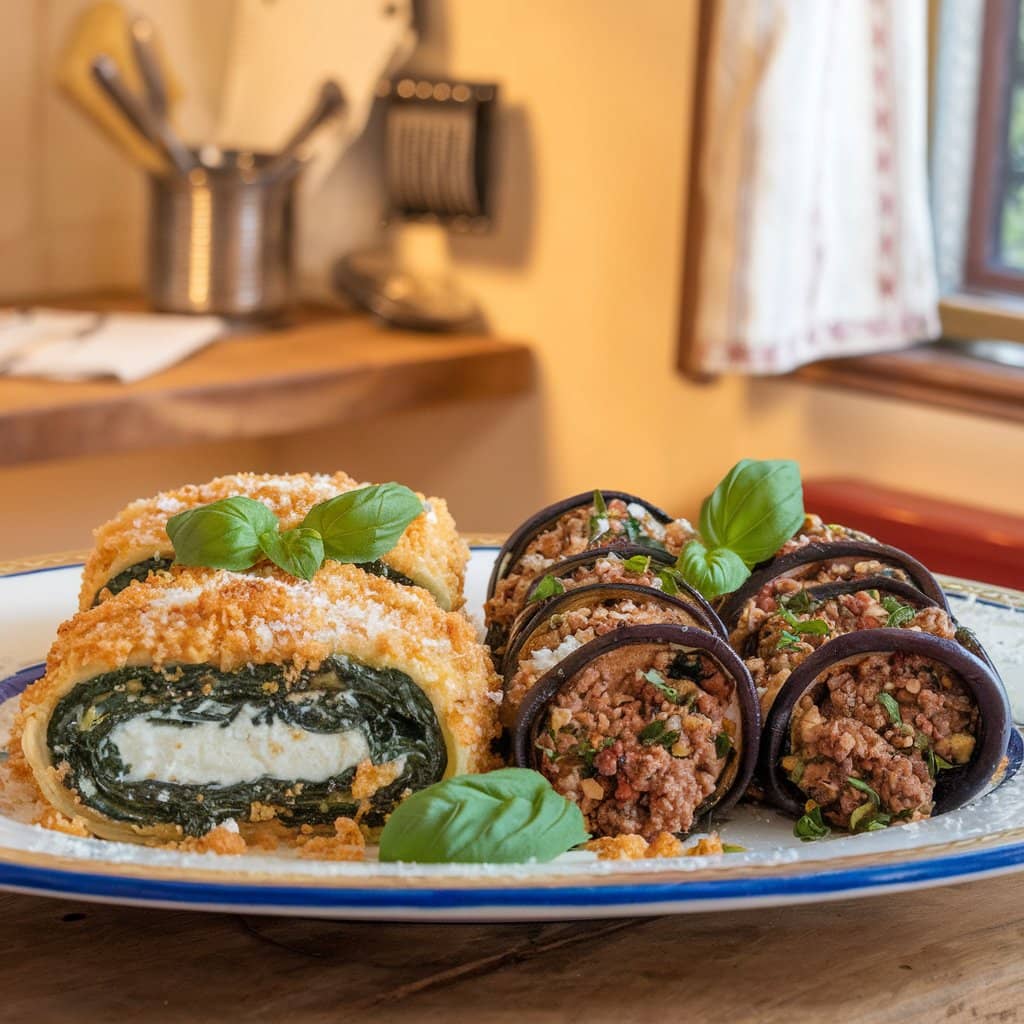Rollatini or Involtini? If you’ve ever wondered about the key differences between these two classic Italian dishes, you’re in the right place. Italian cuisine is like a beautiful love story…”
By doing so, you immediately signal to search engines (and readers) what the article is about, which can help improve your SEO rankings.
Table of Contents
Introduction to Rollatini or Involtini
Italian food has given the world countless culinary treasures, from creamy risottos to perfectly al dente pasta. But what about those lesser-known gems that make your taste buds dance? Rollatini and involtini fall into this category. Though they look and sound similar, these two dishes each have their own unique identity.
So, let’s get down to the basics. What exactly are rollatini and involtini? And why do people mix them up so often?
What Are Rollatini?
Rollatini (sometimes called “rotolini” depending on where you’re dining) is a dish that’s as fun to say as it is to eat. The name comes from the Italian word “rotolo,” which means “roll.” True to its name, rollatini consists of thin slices of vegetables or meat that are rolled up around a filling. Typically, it’s baked with marinara sauce and lots of gooey, melted cheese.

Common Ingredients in Rollatini:
- Vegetables: Eggplant is the star, though zucchini and squash make great alternatives.
- Cheese: Ricotta, mozzarella, and Parmesan combine for a creamy, cheesy center.
- Sauces: Marinara is the most popular, but white sauces or pesto can make a cameo.
- Herbs: Basil, parsley, and oregano add that classic Italian flair.
Rollatini is a crowd-pleaser, offering a warm, cheesy, and comforting bite every time. It’s perfect for vegetarians (eggplant rollatini, anyone?) but can also be adapted with meats like prosciutto for a more indulgent twist.
What Are Involtini?
Involtini, on the other hand, takes a slightly different approach. The name “involtini” comes from “involgere,” meaning “to wrap.” Instead of vegetables, involtini traditionally features thin slices of meat (like beef, pork, or chicken) rolled around a savory filling. Sometimes, even seafood like swordfish is used! It’s then simmered or baked, often with a sauce that enhances its rich flavor.

Common Ingredients in Involtini:
- Meat or Fish: Beef, pork, chicken, or even fish like swordfish.
- Fillings: A mix of breadcrumbs, cheese, nuts, or dried fruit for a sweet-savory combo.
- Sauces: Red wine reductions, marinara, or lemon butter sauces are popular.
- Herbs & Spices: Garlic, parsley, and rosemary create a symphony of flavor.
Involtini feels like a more refined, elegant dish, perfect for special occasions or a fancy dinner party.
Origins of Rollatini and Involtini
Every dish has a story, and rollatini and involtini are no exception. Let’s travel back in time and explore their roots.
Rollatini’s Origins
Rollatini’s rise to fame can be attributed to Italy’s love for eggplant. This vegetable became a staple in Southern Italy due to its ability to thrive in the Mediterranean climate. The dish as we know it today likely evolved from older recipes that used eggplant slices as a canvas for layering flavors.
Involtini’s Origins
Involtini has deeper historical roots, often linked to the ancient Roman practice of stuffing and rolling meats. Over centuries, it evolved into the refined dish we enjoy today, with regional variations showcasing the diversity of Italian cooking.
Key Ingredients and Preparation Styles
Here’s where the two dishes really start to stand apart. While both involve rolling, the choice of ingredients and the method of preparation couldn’t be more different.
Ingredients in Rollatini:
- Eggplant or zucchini for the “wrapper.”
- Ricotta and mozzarella as the creamy filling.
- A hearty marinara sauce for that quintessential Italian touch.
Ingredients in Involtini:
- Thin slices of beef, pork, or chicken as the base.
- Fillings that include breadcrumbs, herbs, and sometimes even raisins or pine nuts.
- A sauce that complements the meat, such as a red wine reduction or tomato-based sauce.
“Cooking is all about bringing ingredients together in harmony. Rollatini and involtini may start with a roll, but their differences lie in the symphony of flavors they create.”
Preparation Techniques: The Art of Rolling
Rollatini’s Technique:
Making rollatini is a straightforward but rewarding process:
- Thinly slice eggplant or zucchini and lightly grill or fry the slices to soften them.
- Spread the cheesy filling across the slices, then roll them up tightly.
- Arrange the rolls in a baking dish, cover with marinara sauce and more cheese, and bake until bubbly and golden.

Involtini’s Technique:
Involtini, on the other hand, demands a bit more finesse:
- Thinly pound the meat to create a flat, even surface.
- Add the filling (breadcrumbs, cheese, herbs) onto each slice.
- Roll up the meat tightly and secure it with toothpicks or kitchen twine.
- Sear the rolls in a hot pan, then simmer in sauce or bake until tender.
Taste and Texture: What Makes Them Unique?
Here’s where your taste buds get to do the talking. Rollatini offers a creamy, cheesy experience that feels indulgent yet light, thanks to its vegetable base. In contrast, involtini provides a heartier, meatier bite, with layers of flavor from the filling and sauce.
Common Problems When Preparing Each Dish
Even the best chefs encounter challenges when preparing rollatini and involtini. But don’t worry—every problem has a solution. Let’s explore some common pitfalls and how to avoid them, so you can create mouthwatering results every time.
Mistakes to Avoid With Rollatini
1. Soggy Eggplant
One of the biggest complaints when making rollatini is ending up with a soggy, unappetizing dish. Eggplant has a high water content, which can make the dish watery if not handled correctly.
Solution:
- Salt the eggplant slices before cooking to draw out excess moisture. Let them sit for 15–20 minutes, then pat them dry with a paper towel.
- Grill or lightly fry the slices before rolling to add flavor and remove additional water.
2. Filling Spilling Out
Ever had your rollatini fall apart because the filling oozed out mid-bake? It’s frustrating, but preventable.
Solution:
- Avoid overfilling the slices. Use a thin, even layer of filling that can be easily rolled without spilling.
- Roll tightly, but not so tight that the filling squeezes out from the sides.
3. Burnt Cheese on Top
No one enjoys scraping burnt cheese off a casserole dish. While cheese is essential for rollatini, too much exposure to high heat can turn golden goodness into a crispy disaster.
Solution:
- Cover the baking dish with aluminum foil for the first 20 minutes of baking. Remove the foil for the last 10–15 minutes to let the cheese melt and brown beautifully.
Challenges in Making Involtini
1. Tough Meat
Involtini should be tender and juicy, but improperly prepared meat can result in a chewy, unpleasant texture.
Solution:
- Pound the meat thinly and evenly to break down fibers and make rolling easier.
- Cook the meat gently, whether simmering in sauce or baking, to avoid overcooking and drying it out.
2. Rolls Falling Apart
Involtini can unravel during cooking if they’re not secured properly.
Solution:
- Use toothpicks or kitchen twine to hold the rolls together during cooking. Remember to remove them before serving.
- Roll the meat snugly around the filling, ensuring the seam is on the bottom when placing them in the pan or dish.
3. Overpowering Fillings
A common mistake is creating fillings that dominate the dish, overpowering the natural flavor of the meat.
Solution:
- Keep the filling balanced. Use complementary ingredients like breadcrumbs, cheese, and herbs to enhance the flavor, not overshadow it.
- Avoid overly salty or spicy fillings unless you’re aiming for a specific flavor profile.
“Great cooking isn’t about perfection—it’s about learning from mistakes and making adjustments. With a little patience, your rollatini and involtini will shine!”
Solutions and Tips for Perfecting Both Dishes
Whether you’re a beginner or a seasoned pro, these tips will help you elevate your rollatini and involtini game.
Expert Tips for Rollatini
- Use Fresh Ingredients: Opt for fresh eggplant and herbs for the best flavor. Frozen vegetables can be watery and lack the vibrant taste of fresh produce.
- Experiment With Fillings: While ricotta is traditional, you can add spinach, mushrooms, or even cooked sausage for a unique twist.
- Bake in Layers: If you’re serving a crowd, layer the rollatini like a lasagna for a show-stopping presentation.
Mastering Involtini
- Choose Quality Meat: Thin, high-quality cuts of meat like veal or chicken breast work best. Avoid overly fatty or gristly cuts.
- Deglaze the Pan: After searing the involtini, deglaze the pan with wine or broth for a rich, flavorful sauce.
- Get Creative: Try regional variations, like Sicilian swordfish involtini or Northern Italian veal involtini stuffed with cheese and prosciutto.
Popular Variations Around the World
Both rollatini and involtini have inspired countless variations that cater to different tastes and cultures. Here are some of the most beloved twists on these classic dishes.
Rollatini Variations
- Zucchini Rollatini: Perfect for those avoiding eggplant, zucchini offers a mild, slightly sweet alternative.
- Spinach and Ricotta Rollatini: Add chopped spinach to the filling for an extra burst of nutrition.
- Chicken Rollatini: Swap out the vegetable base for thinly pounded chicken breast for a protein-packed option.
Involtini Around the Globe
- Sicilian Swordfish Involtini: This coastal twist features thin slices of swordfish filled with breadcrumbs, pine nuts, and raisins.
- Greek Dolmades: Similar in concept, these involve grape leaves wrapped around a rice and herb filling.
- Stuffed Cabbage Rolls: While not Italian, stuffed cabbage rolls share the same “rolled and stuffed” concept, with fillings tailored to Eastern European flavors.
“Cooking is like painting—you can start with a traditional base and add your own flair to create something unique and unforgettable.”
Which Dish is Better for You: Rollatini or Involtini?
When it comes to choosing between rollatini and involtini, it all boils down to your preferences, dietary needs, and the occasion. Let’s break it down to help you decide which dish might be the best fit for you.
Healthier Option
If you’re watching your calorie intake or looking for a lighter dish, rollatini might be your go-to option. Here’s why:
- Vegetable Base: Rollatini, especially when made with eggplant or zucchini, is naturally lower in calories and carbs compared to meat-based involtini.
- Vegetarian-Friendly: It’s a great option for vegetarians or those trying to eat more plant-based meals.
- Less Fat: Using fresh vegetables and a light cheese filling makes rollatini a heart-healthy choice.
On the other hand, involtini can be tailored to be healthier too. Opt for lean cuts of meat, like chicken or turkey, and use minimal oil during cooking. You can even skip the breadcrumbs for a low-carb alternative.
Best Fit for Different Occasions
Both dishes can shine in different settings:
- Casual Family Dinner: Rollatini’s comforting, cheesy goodness makes it perfect for a weeknight meal with loved ones.
- Special Occasions: Involtini’s elegant presentation and rich flavors make it ideal for holidays, dinner parties, or romantic evenings.
- Meal Prep: Both dishes can be prepped in advance, but rollatini might edge out involtini for its reheating ease and versatility.
“Choosing between rollatini and involtini is like picking a favorite movie—it all depends on your mood and what you’re craving!”
Conclusion: Choosing Between Rollatini or Involtini
So, what’s the final verdict? The truth is, there’s no right or wrong choice between rollatini and involtini. Both dishes are unique in their own way and offer endless opportunities for customization.
- Craving something light and cheesy? Go for rollatini.
- In the mood for something hearty and indulgent? Involtini is your winner.
- Want to experiment? Try both and put your own spin on these Italian classics!
No matter which dish you choose, the joy of cooking (and eating!) is about savoring the experience and sharing it with the people you love. So, why not roll up your sleeves and try both? After all, who says you can’t have the best of both worlds?
Final Thoughts
Italian cuisine is a treasure trove of flavors, and rollatini and involtini are just two shining examples of its brilliance. Whether you’re a fan of creamy vegetable rolls or savory meat wraps, these dishes offer something for everyone. Now that you know their differences, you’re all set to impress at your next meal.
Happy cooking, and buon appetito!

